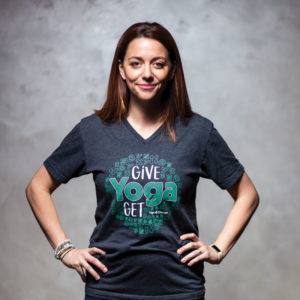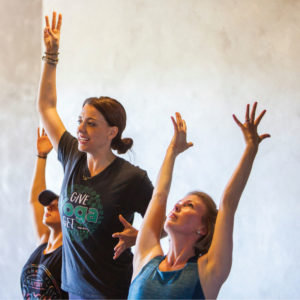A Pilot Finds a New Mission
A Pilot Finds a New Mission
A former Navy pilot makes it her mission to help others “live with hope” by bringing yoga to populations that have been left out of the meditative exercise.

Kathryn Monti Thomas ’07
When Kathryn Monti Thomas ’07 was 11 years old, she saw a Navy helicopter demonstration. That’s when she knew she wanted to fly.
At Rochester, Thomas took steps to pursue that dream. She was a double major in political science and religion and a four-year member of the swim team. As a Naval ROTC midshipman, she was commissioned as an ensign and set off for flight school in Florida.
After earning her wings as a Naval aviator, she was deployed to the Mediterranean. Five and a half years into her Navy career, though, she fell and broke her ankle. The injury was so severe that she had to have multiple surgeries and lost feeling in her left leg. She could no longer fly.
“The Navy wants deployable pilots,” she says. “That wasn’t me anymore.” After one last surgery, she was medically separated from the Navy.
To help rehabilitate her ankle—and to help navigate the devastation of the loss of her Naval career—Thomas tried yoga. And she began to feel different. “For that hour on my yoga mat, I could finally stop ruminating about who I wasn’t going to be, and I became okay with who I was.”
Hoping to share that reclaimed sense of self with others, Thomas started Yoga 4 Change (y4c.org) in 2014. Based in Jacksonville, Florida, the nonprofit organization strives to bring meaningful change to the lives of veterans, incarcerated people, youth, and those in recovery. Today, Yoga 4 Change has programs in more than 80 facilities throughout 10 Florida counties.
“We try to heal and serve the underserved. I want for others what I have found through yoga: live with hope.”

BREATHING ROOM: Thomas says working with people who otherwise wouldn’t be able to take the time to “breathe and give yourself some space” makes an enormous difference in their lives.
Sharing the benefits of the ancient physical and meditative practice—including lowered blood pressure, blood sugar levels, and heart rate, as well as increased self-esteem, sense of peace, and creative thinking skills—the program aims to provide practitioners with ways to manage anger, stress, and mental and physical challenges.
“Participants work through and release their negative emotions on their mats,” Thomas says. “They learn to calm their minds and bodies, build confidence, and find inner strength.”
Each class includes a therapeutic writing component, which gives those in the classes a chance to document, confront, and discuss their feelings. Thomas has seen differences that taking the time “to breathe and give yourself some space” can make in people’s lives.
She recalls teaching at a women’s correctional facility, where a member of the class was a young woman whose wrists were wrapped in gauze. “She showed me her arms and asked me if she could still take the class,” Thomas says. “I said, yes, of course.”
The young woman sat, breathed, and moved through some postures. When she did a movement in which practitioners lie prone and then use their arms to lift their chests toward the sky, she let out a big sigh. “Immediately, I thought, ‘oh no, she split her stitches,’” Thomas says.
With each uplifting movement, the young woman smiled. Later, in the notes about the class, she revealed that she had been a human trafficking victim and that going through the class was the first time in a long time that she felt in control of her body. And it brought her some happiness.
“That allowed me to see that we had created a space in that jail that was secure enough for her to let her guard down and to feel alive,” Thomas says.
At the end of every class, Thomas thanks each person.
“Even if they didn’t have a choice in being there, I thank them for coming,” Thomas says. “Telling people they matter shows them that they aren’t invisible. Having these meaningful connections is powerful, and can change lives.”
— Kristine Thompson
This article originally appeared in the fall 2019 issue of Rochester Review magazine.


